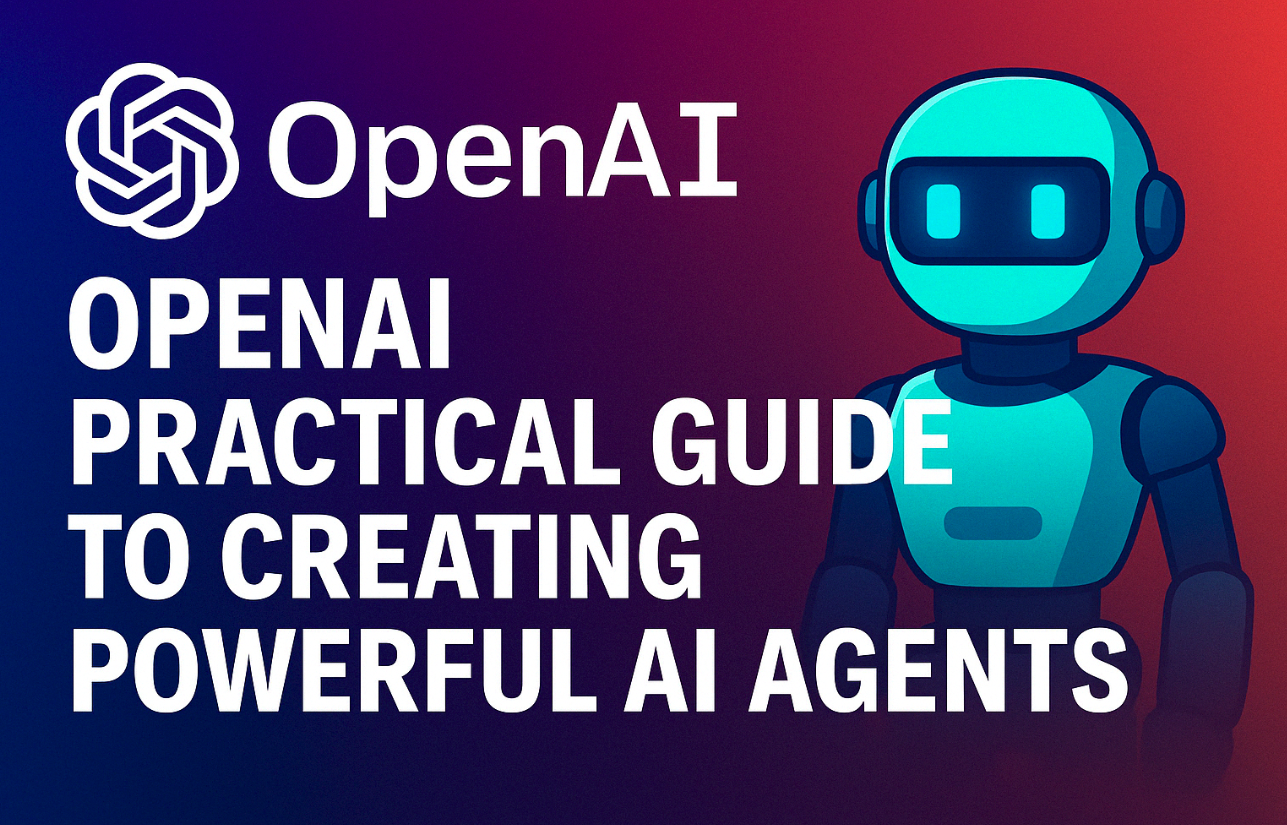Open AI practical Guide to Creating Powerful AI Agents!
Artificial Intelligence (AI) continues to reshape industries, automate workflows, and transform our daily lives. Among its most fascinating innovations are AI agents—intelligent digital assistants capable of thinking, acting, and interacting just like humans. Whether you're a beginner or a seasoned developer, building your own AI agent is exciting and increasingly accessible. This guide will explore how you can build these intelligent assistants easily, practically, and safely.
What Exactly Are AI Agents?
Imagine having an assistant who doesn't just follow commands but independently performs tasks, from researching online information and scheduling meetings to managing customer interactions and analysing large datasets. An AI agent is exactly that—a sophisticated AI system leveraging powerful language models, tools, and clear instructions to complete tasks autonomously.
Key Capabilities of AI Agents:
Customer Support Automation: AI chatbots answer customer queries in real-time.
Data Analysis: Automatically summarising reports and datasets.
Web Browsing: Retrieving up-to-date news and information online.
Routine Task Automation: Handling repetitive tasks like scheduling and data entry.
Why Build Your AI Agent?
AI agents offer immense value:
Efficiency: Automate tedious or complex tasks to save significant time.
Problem-solving: Easily handle challenging, multi-step problems.
Accessibility: Thanks to platforms like OpenAI, anyone with basic coding knowledge can get started.
Future-Proof Skills: AI agents represent a booming field, impacting sectors from education to healthcare.
How to Create AI Agents: The Three Essential Ingredients
Creating effective AI agents involves three crucial components:
1. Models – The Agent’s Brain
The AI model, like GPT-4 or GPT-4o, acts as the cognitive core, interpreting inputs, generating responses, and deciding subsequent actions.
Choosing the Right Model:
For simple tasks (FAQs), a lightweight model is sufficient.
For advanced tasks (complex analysis or coding), a more robust model is necessary.
Example: If you're building a virtual shopping assistant, a basic model could answer product availability questions. But recommending personalized products based on user behavior requires a stronger AI model.
2. Tools – The Agent’s Hands
AI agents use tools to interact with external environments, perform actions, and gather information. Common tools include:
Web browsers for information retrieval.
File management tools to access and summarize documents.
API integrations for advanced tasks.
Example: A healthcare agent assisting patients might use web search tools to find relevant medical information and APIs to access secure patient records.
3. Instructions – The Agent’s Rulebook
Clear instructions guide the agent's behavior and task execution:
Specific instructions ensure precision.
Include illustrative examples.
Clearly outline restrictions and guidelines.
Example: A banking customer service AI would follow instructions like "Provide account balance when asked, ensure responses are polite, and escalate complex financial inquiries to human staff."
Building Your AI Agent: Step-by-Step Guide
AI agents can function as either single-agent systems or multi-agent teams:
Single-Agent Systems
A straightforward approach for basic tasks:
Receives task input.
Executes using provided model, tools, and instructions.
Reviews completion status or performs additional steps if necessary.
Example: A restaurant booking agent:
Understands user request via AI model.
Uses a web API to find table availability.
Confirms booking and sends details back to the user.
Multi-Agent Systems
Multiple agents collaborate on complex tasks:
Each agent specializes in a specific sub-task.
Agents communicate results and coordinate.
Example: A business analysis team:
Agent 1: Gathers market data online.
Agent 2: Summarizes key financial trends.
Agent 3: Generates a comprehensive report.
A manager coordinates and integrates their efforts seamlessly.
Ensuring Agent Safety and Reliability
Reliability is critical. Two essential methods ensure agent safety:
Guardrails
Protect agents from mistakes by:
Validating inputs to prevent harmful actions.
Checking outputs to ensure relevance and appropriateness.
Limiting tool usage to safe parameters.
Example: An educational AI blocking inappropriate or unreliable educational content sources.
Human Oversight
Crucial for sensitive or complex operations:
Agents flag certain tasks for human review.
Humans verify and approve critical outcomes.
Example: Financial transaction agents may draft recommendations but require human verification before final processing.
Practical Success Tips
Start Small: Build a basic AI agent to gain experience.
Test Continuously: Refine instructions and tools based on performance.
Optimize Balance: Select models based on accuracy, speed, and cost-effectiveness.
Monitor Closely: Track and analyze agent activities regularly.
Essential Tools and Resources
OpenAI simplifies AI agent development with:
Agents SDK: Free, easy-to-use tools available on OpenAI’s GitHub.
Responses API: Offers advanced features like web browsing and document analysis.
All you need:
Basic Python skills.
An OpenAI API key.
Curiosity and enthusiasm to experiment.
Why AI Agent Development Matters
Developing AI agents is more than technical innovation—it’s shaping the future by democratising powerful AI technologies. OpenAI’s straightforward approach ensures everyone from students to professionals can innovate and solve real-world problems effectively.
Your Next Steps in AI Agent Development
Ready to begin?
Download the Guide: Access OpenAI’s detailed resources.
Set Up: Obtain an API key and install necessary tools.
Experiment: Build your first simple agent.
Share and Learn: Engage with developer communities online.
Conclusion: Build the Future Today!
Building your own AI agent is not only achievable but profoundly empowering. With clear models, effective tools, detailed instructions, and safety mechanisms, you can create intelligent agents to automate, enhance, and revolutionise tasks in any industry.
Start exploring now—your AI agent-building adventure awaits!
